- Performance enhancement of concrete by using ceramic waste as a partial replacement for coarse aggregate
M. Harikarana,*, P. Kulanthaivelb, A.R. Krishnarajac and P.C. Murugand
aAssistant Professor, Department of Civil Engineering, Muthayammal Engineering College, Rasipuram - 637408, Tamilnadu, India
bAssistant Professor, Department of Civil Engineering, Kongu Engineering College, Perundurai-638060, Tamilnadu, India
cAssociate Professor, Department of Civil Engineering, Kongu Engineering College, Perundurai-638060, Tamilnadu, India
dAssociate Professor, Department of Automobile Engineering, Kongu Engineering College, Perundurai-638060, Tamilnadu, IndiaThis article is an open access article distributed under the terms of the Creative Commons Attribution Non-Commercial License (http://creativecommons.org/licenses/by-nc/4.0) which permits unrestricted non-commercial use, distribution, and reproduction in any medium, provided the original work is properly cited.
A significant quantity of the world's volume of construction and demolition waste comes from the ceramic and construction sectors. To reduce such waste, ceramic waste is used as one of the ingredients of concrete material in this study to improve the engineering characteristics of the concrete. In this investigation, ceramic waste aggregate is used in place of natural coarse aggregate in proportions of 0%, 20%, 40%, 60%, 80% and 100%. Laboratory studies on Compressive strength, Split Tensile strength, Flexural strength, and Shear strength were carried. The findings of experimental tests showed that adding ceramic waste increased the compressive strength of CRWAC40's (Ceramic Waste Aggregate Concrete) as compared with CC (Conventional Concrete) and the values of compressive strengths being 37.75 MPa and 36.25 MPa respectively. CC and CRWAC40 have split tensile strengths of 3.15 MPa and 3.58 MPa respectively. In this case, the split tensile strength of CRWAC40 is increased by 13% when compared to conventional concrete. Flexural and shear strengths of CC and CRWAC40 are 5.32 MPa, 7.48 MPa and 5.72 MPa, 7.82 MPa respectively. Based on the laboratory test results, it has been concluded that ceramic waste aggregate could be used up to 40% in replacement of conventional coarse aggregate in concrete to improve its engineering properties
Keywords: Ceramic waste aggregate, Concrete, Coarse aggregate, Shear strength
Due to its superior ability to be shaped in any desired way, concrete is the most extensively utilized artificial construction material in the world. N.M. Azmee and N. Shafiq [1] said that every year, approximately five billion tonnes of concrete are used worldwide. It costs between 25 and 30% of the budget. In India, total concrete consumption is found to be 470 and 580 million tonnes in 2017 and 2022, respectively. Therefore, we must locate waste materials to replace the ones we take from nature. Tayeh et al. [2] concluded that recycling, reusing and substituting ingredients is one solution to the shortage of high-quality aggregates.
Kumar and Agrawal [3] demonstrated that the waste from different industries can be dumped in low-lying areas but due to land costs in urban areas, dumping space is limited. Considering the cost of land, lead charges have an impact on waste disposal and cause pollution in the surrounding areas. Ogrodnik and Szulej [4] identified that ceramic waste aggregate is created in huge amounts due to its extensive use in construction. Nearly 30% of waste is produced during the production, transit and use of goods, primarily as a result of development and destruction waste. There is more waste because of its brittle nature. The shape coefficient of coarse ceramic aggregate made from industrial waste and crushed ceramic aggregates is comparable to that of coarse aggregate made through crushing. Ceramic aggregate is usually non-porous, irregularly shaped, and angular. However, porous aggregate can be produced by crushing and chiselling ceramic material with a hammer.
Manufacturing cladding tiles, floor tiles, sanitary ware and roof tiles are all small-scale ceramic businesses that are active in central India, particularly in the state of Gujarat. Ahmad [5], concluded that the structural properties of these concrete mixes are tested and optimistic results were obtained for the optimum percentage of substitution. According to previous research, ceramic products are hard, durable, inert and have adequate abrasion resistance. Ceramic waste aggregate and natural aggregate properties are compared to determine whether it is feasible to produce concrete from ceramic waste aggregate. A plain concrete beam specimen has been used to test the compressive, split tensile and flexural strengths of ceramic waste aggregate concrete. The S type double L push specimens have been used to investigate the shear behaviour of ceramic waste aggregate concrete as demonstrated by Ray et al. [6].
Ray et al. [7], identified that, as a result of these studies, ceramic aggregate concrete has been found to have mechanical and long-term qualities similar to regular concrete. The findings demonstrate that producing medium and high-strength concrete is possible when ceramic aggregates are used in place of natural aggregates.
Goyal et al. [8], identified that, the replacement levels of 0%, 5%, 10%, 15%, 20%, and 25% of crushed ceramic tiles were utilized in place of natural aggregates in concrete. The results show that ceramic waste enhances concrete performance up to a specific amount of replacement.
In order to eliminate ceramic waste from production industries, the study's objectives are to determine the compressive, tensile, flexural and shear strengths of concrete using ceramic waste aggregate as a partial replacement of coarse aggregate.
Cement
Ordinary Portland Cement of grade 53 in compliance with IS 12269-1987 was provided by Sri Devi Traders, Erode, Tamil Nadu. The Indian Standard Code was used to determine the physical characteristics of cement and the findings are reported in Table 1.
Fine Aggregate
The river sand used in this study was collected in Karur, Tamil Nadu. The test results are compiled in Table 2 and the physical characteristics of river sand were determined in accordance with Indian Standard. Dhirobe et al. [9] said that, Sand from rivers served as the fine aggregate and conformed to IS: 383-1970 Zone-II of Table 4.
Natural Coarse Aggregate
The coarse aggregate used in this research was purchased from Ramakrishna Crushing Unit, Erode, Tamil Nadu. Chhetri et al. [10], said that the experiment's coarse aggregate had a maximum size of 20 mm. Table 3 displays the outcomes of Physical properties of Natural coarse aggregate.
Ceramic Waste Aggregate
The ceramic garbage has been collected from the Shirdi Sai Electricals-Kadapa trash dump, Andhra Pradesh (India). Table 4 summarizes the physical characteristics of ceramic waste aggregate. Fig. 1 shows the aggregate made from crushed ceramic waste. According to the experimental findings in Table 4, Ceramic waste is durable, hard, does have a lower specific gravity, is low in density and absorbs water with a slightly greater rate. The ceramic waste functions well in place of coarse aggregate in producing concrete.
Mix design for concrete
The Indian standard recommended method IS10262-2009 is used to create a design of the concrete mix for M20 grade, with target strength of 26.6 MPa, stated by Santhosh and Shivananda [13]. Table 5 displays the number of ingredients utilized to prepare the concrete.
In the preceding Table 5, Concrete that is prepared conventionally abbreviated as CC and CRWAC stands for ceramic waste aggregate replacement concrete, which substitutes ceramic waste aggregate for natural coarse aggregate by a percentage of 20%. In the experimentation work, same nomenclature was suggested as CRWAC40 through CRWAC100.
Compressive Strength Test
According to the IS 516-1959, cube specimens measuring 150 × 150 × 150 mm were cast and the coarse natural aggregate was replaced by ceramic waste aggregate to investigate the compression behaviour of ceramic waste aggregate concrete. A total of 36 cube examples were cast; 6 of them were made with natural coarse aggregate and the remaining samples were cast by substituting 20%, 40%, 60%, 80% and 100% of natural coarse aggregate with waste ceramic aggregate. In testing work of all of the mixtures, the fine aggregate used was clean river sand. Fig. 2 shows the testing of cube specimen in CTM.
Split Tensile Strength Test
It is crucial to test at least three specimens for the appropriate ages in order to determine the split tensile strength for 7 and 28 days. To ensure proper placement of the specimen in the compression testing machine, a diametrical line connecting the two ends of the specimen was drawn before testing. The fabrication and testing procedure has been followed according to IS 516-1959. Fig. 3 shows the setup for split tensile strength.
Flexural Strength Test
This test is to estimate the load at which a concrete specimen will split into pieces. Whatever factors affect compressive strength will also affect the modulus of rupture. This is due to aggregate stiffness which affects not only the proportion of the load carried by the aggregate but also the stiffness of the concrete. Flexure modulus testing was carried out using a symmetrical third point loading pattern. According to IS 516-1959, the size of the specimen is 150 × 150 × 700 mm.
Ralli and Pantazopoulou [14], said that, the load points were marked at one-third of the span and the theoretical maximum tensile stresses that reached the test beam's bottom fibre, known as the Modulus of rupture, were calculated. Under third-point loading, one-third of the length of the beam's extreme fibre was subjected to the highest stresses, resulting in the critical crack developing at any point along one-third of the beam's length. Cazacu and Baudard [15], said that, the centre-point loading test will yield a higher value of modulus of rupture but more variable values. As a result, the centre-point loading test is rarely used to determine flexural strength. Fig. 4 and 5 shows the test setup for a third-point loading specimen and propagation of crack under the roller.
Shear Strength Test
Concrete's shear strength is defined as how well one layer holds up against another as they slide across a shared area of contact. Since two planes do not fail simultaneously under double shear, the shear strength estimated in this way is incorrect. Jumaa and Yousif [16], clearly said that one of the most dangerous types of failure is concrete failure caused by a lack of shear resistance because shear failure happens suddenly and without warning. Hence the structural members face a major issue. There isn't a standardized, trustworthy or straightforward way to assess concrete shear strength using a compressive testing machine. Sloped cracks are produced by shear. Shear failures often occur under diagonal tension, though they can also occur in diagonal compression. Kristiawan et al. [17], stated that since shear resistance in reinforced concrete depends on both tensile and compressive strength, shear failure is often brittle in concrete structures. For examining the shear behaviour of concrete with ceramic aggregate, a double L specimen with an internal dimension of 27.94 × 20.32 cm was used. The legs and heads of the L shape were reinforced to increase their tensile strength. Figs. 6 and 7 shows the testing setup for shear specimen in CTM. 10 mm diameter steel reinforcement has been added to improve shear resistance.
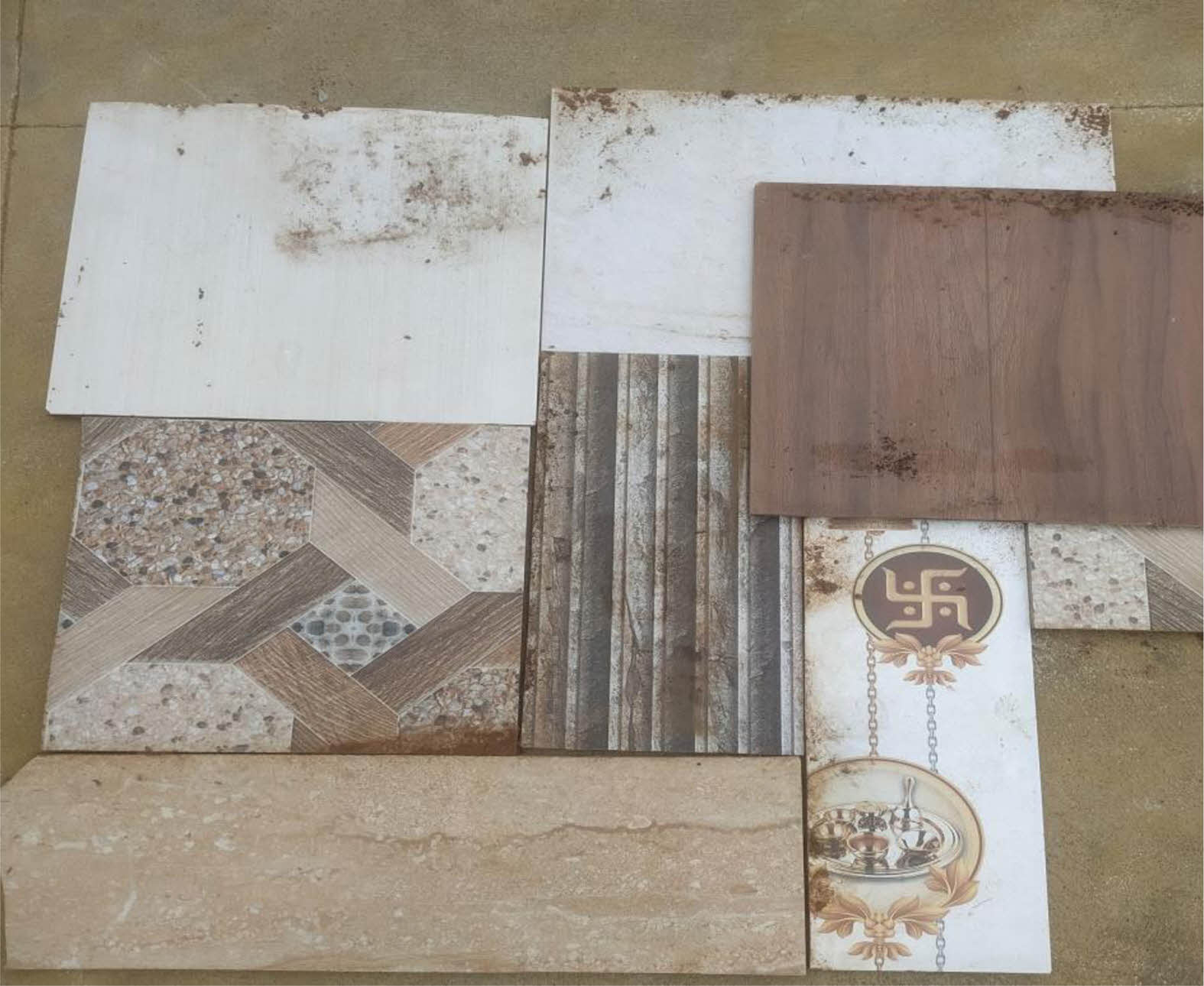
|
Fig. 1 Ceramic waste materials |
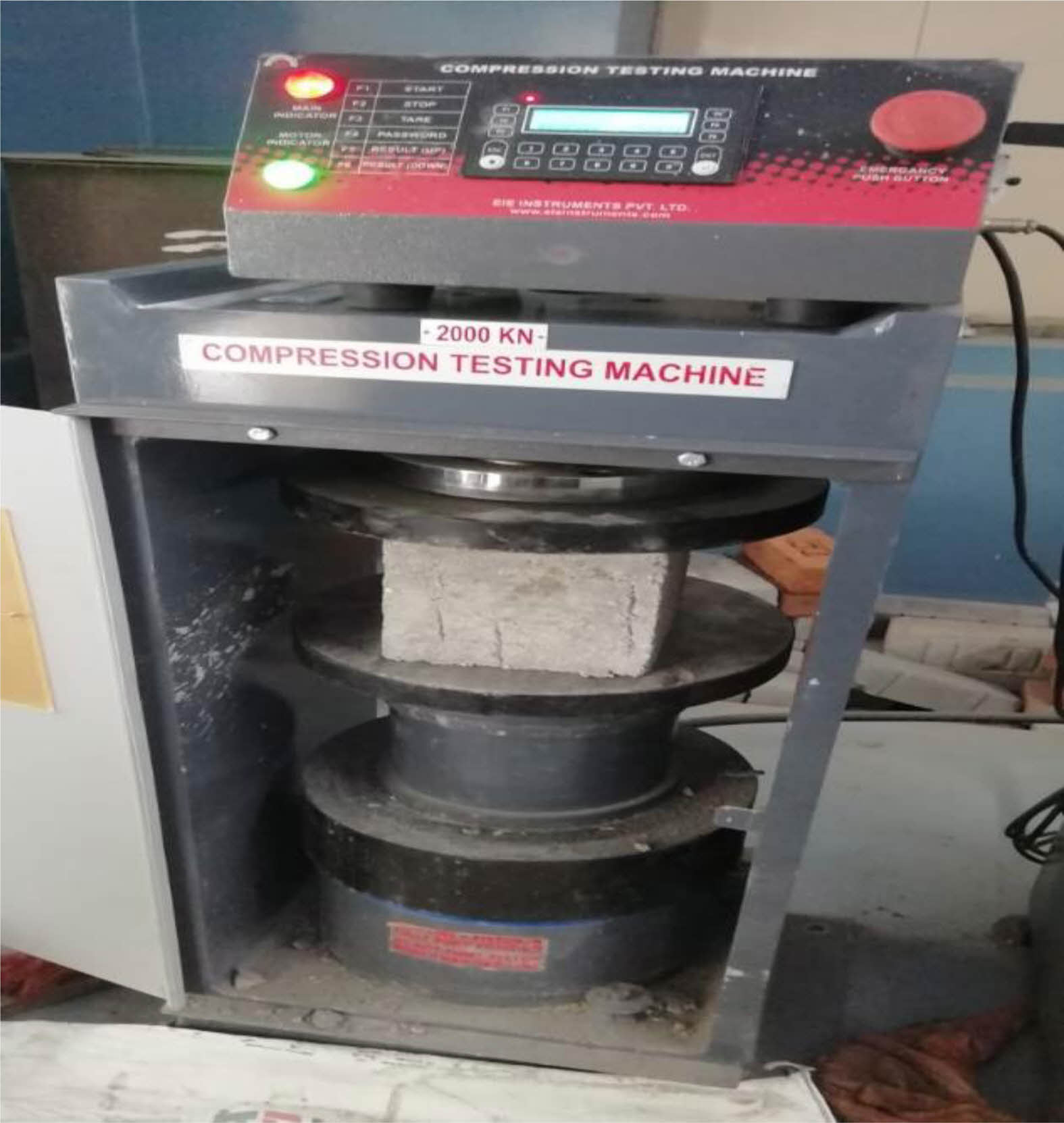
|
Fig. 2 Testing of concrete cube specimen in CTM. |
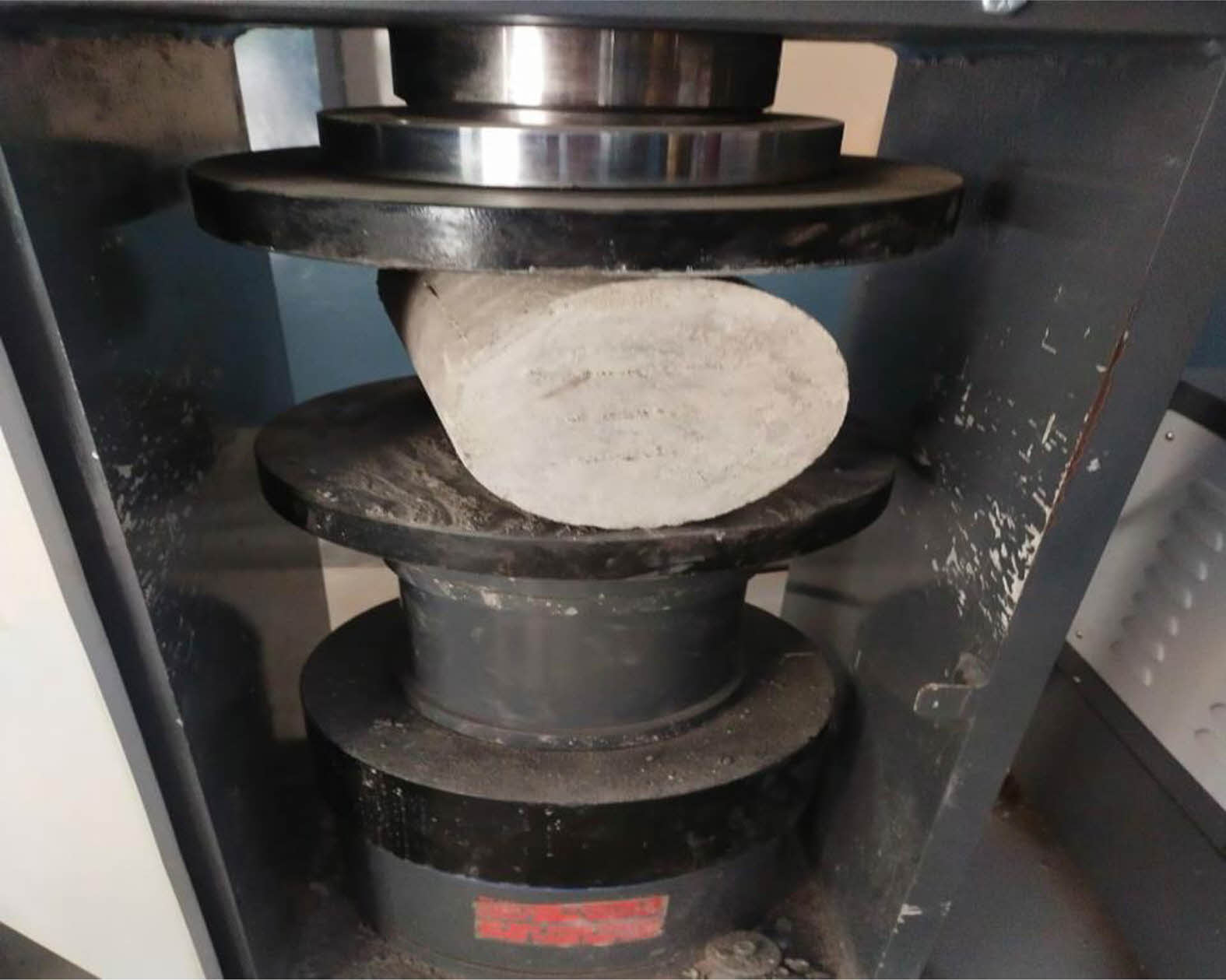
|
Fig. 3 Testing of cylinder specimen in CTM. |
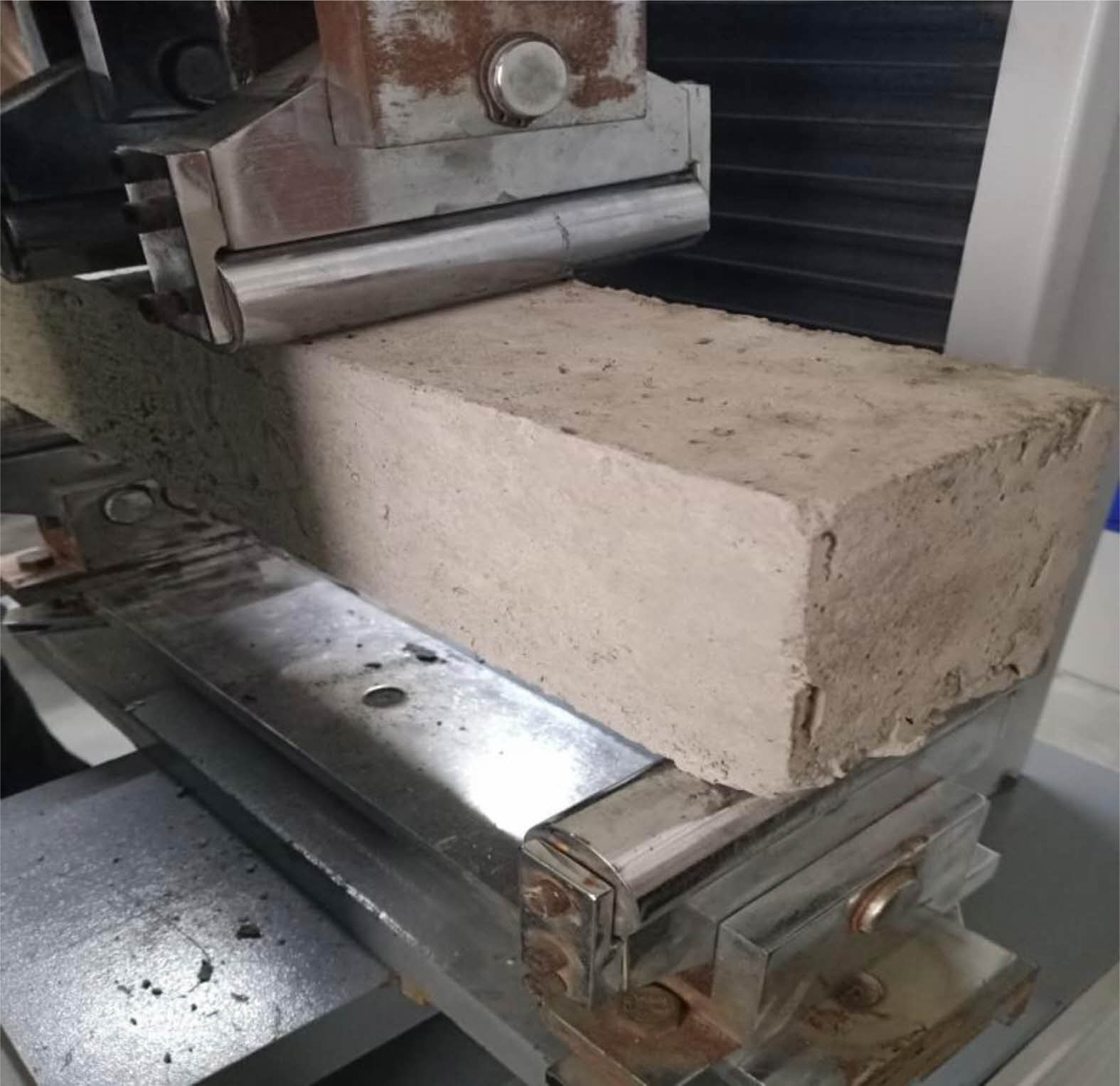
|
Fig. 4 Loading of beam specimen. |
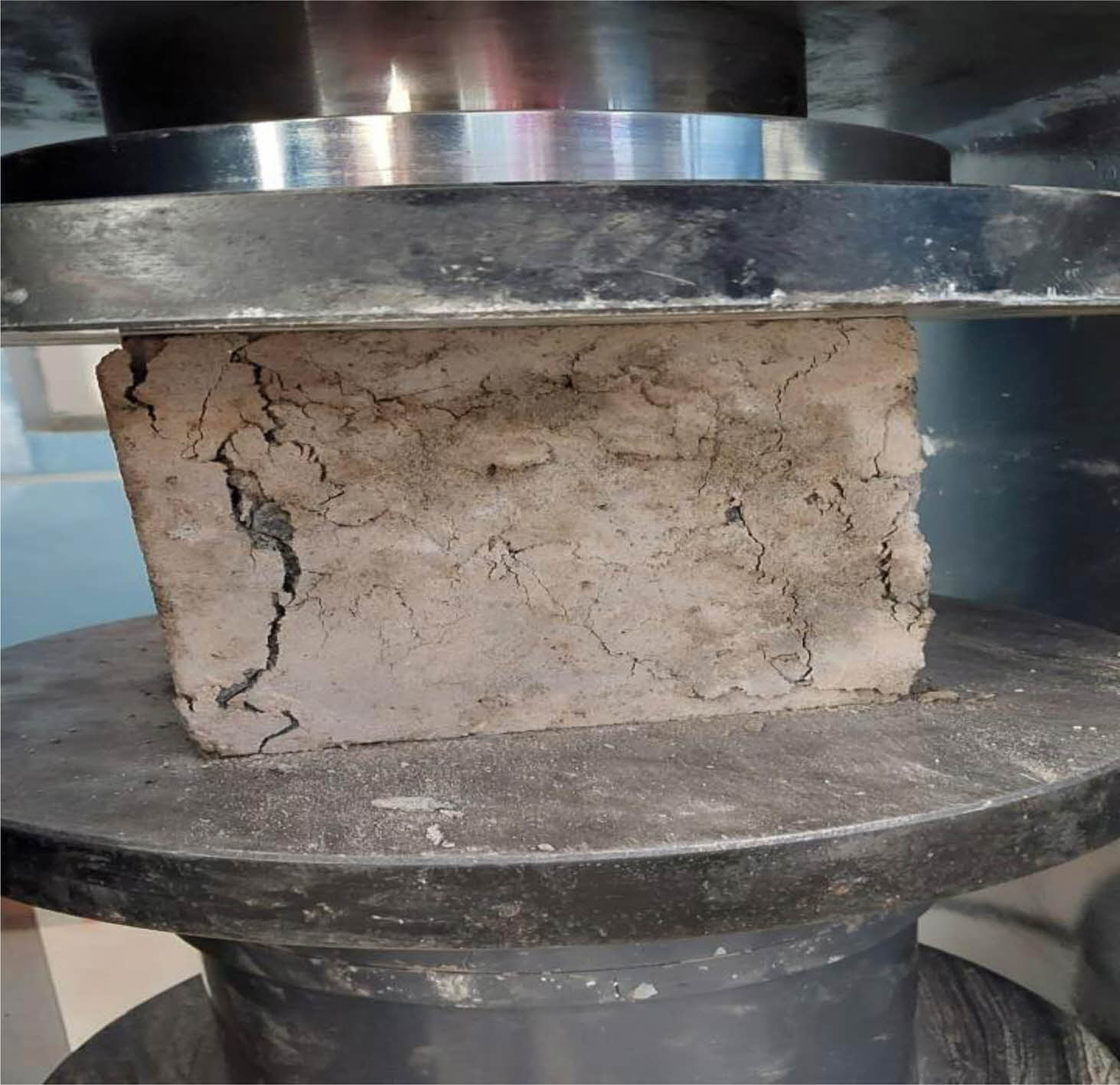
|
Fig. 5 Propagation of crack under the roller |
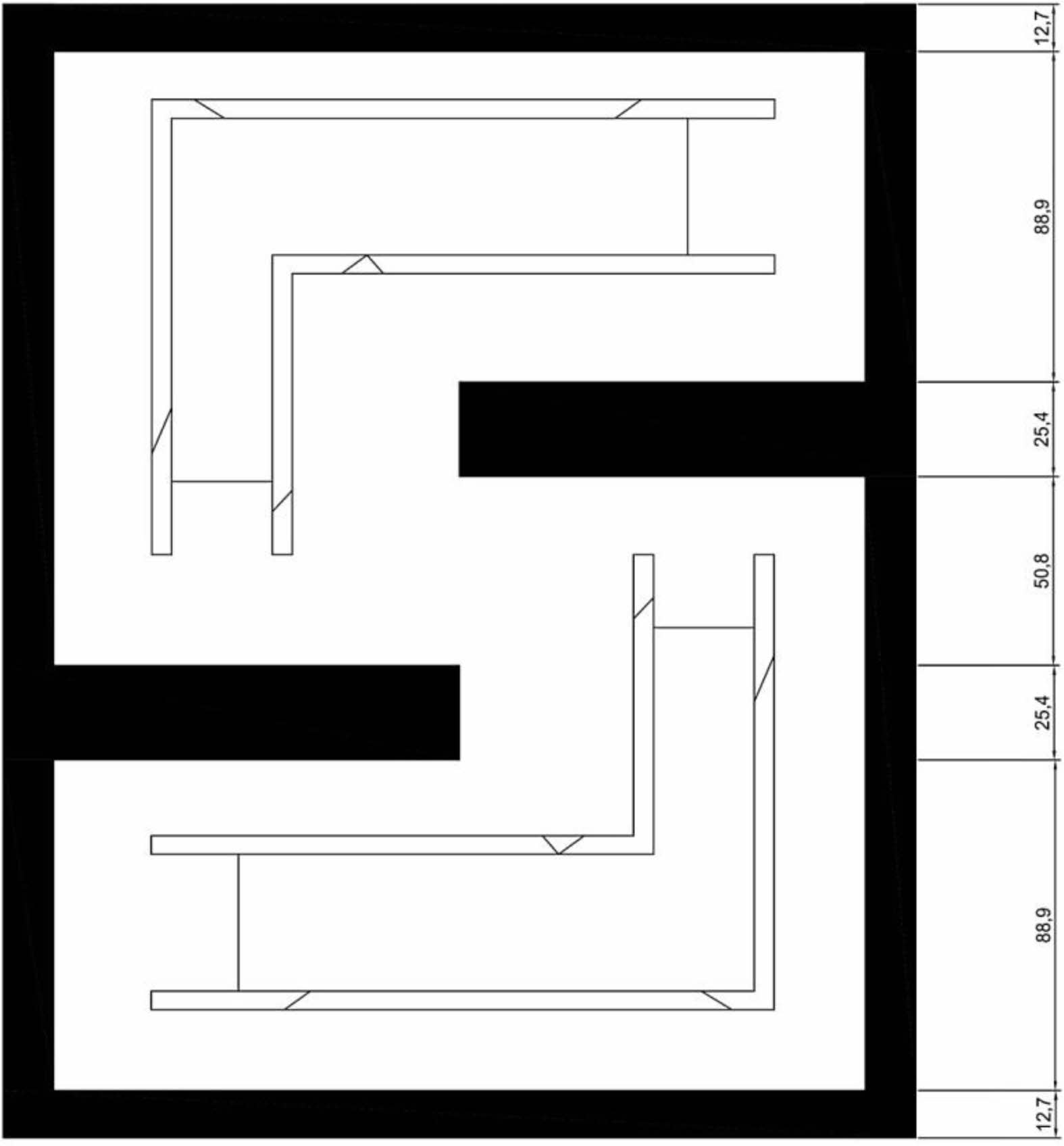
|
Fig. 6 Plan view of shear mould. |
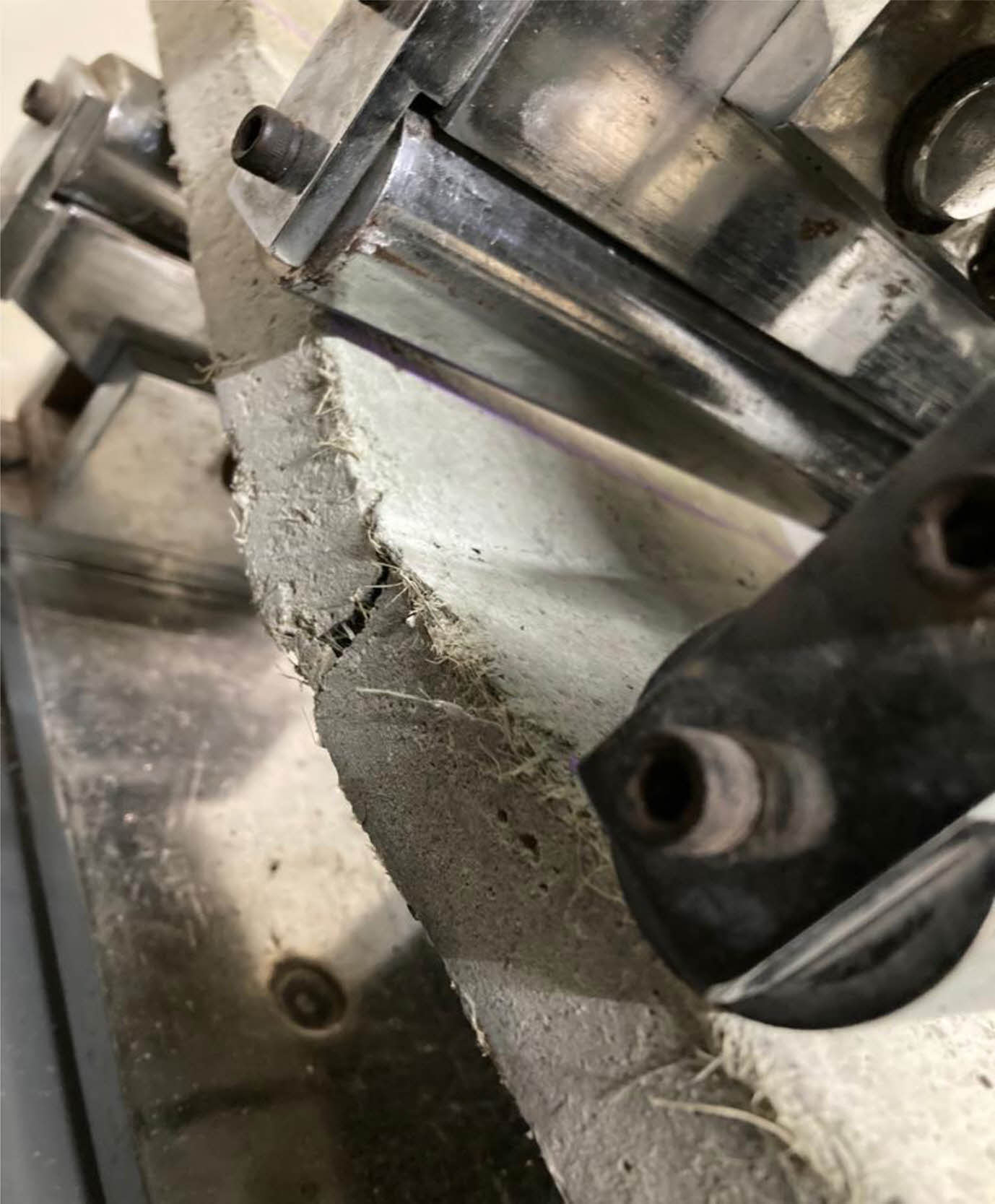
|
Fig. 7 Testing of shear specimen in CTM. |
The effect of ceramic waste material on concrete's Compressive strength
Figs. 8 and 9 shows the impact of waste ceramic aggregate on the concrete's compressive strength after 7 and 28 days. Ceramic waste aggregate was substituted for conventional aggregate in the proportions of 0%, 20%, 40%, 60%, 80% and 100%. According to the experimental results, 40% replacement of ceramic waste aggregate with natural coarse aggregate results in higher compressive strength. Comparing compressive strength in CC and CRWAC confirms that when coarse aggregate is substituted for 40% of the ceramic waste aggregate, the strength is confirmed to be higher by 4.13% than that of regular concrete specimens. This is because the surface of waste ceramic aggregate is more angular than gravel. As a result, it allows the waste ceramic aggregate to bond better with other aggregates and to fill more air voids than gravel, which has showed a smoother surface. Therefore, the angularity of the waste ceramic aggregate may have assisted in the increase of concrete's compressive strength. The compressive strength in concrete decreases when coarse aggregate substitution by ceramic aggregate is more than 40%. This might be because waste ceramic aggregate has smoother surface texture and higher water absorption capacity, which weakens the bonding between the aggregate components in concrete.
Jacob et al. (2017), found that Concrete's compressive strength can be raised by up to 40% when ceramic waste aggregate is used as the coarse aggregate. Daniyal and Ahmad [20], stated that the Waste ceramic tile used in the manufacturing of concrete has no apparent negative effects on the concrete's characteristics. The best-case situation for using waste ceramic tiles as coarse aggregates is found to be 10% to 30%. These measurements show an increase in compressive strength as well as a decrease in unit weight. Shruthi et al. [21], investigated that the maximum compressive strength was attained when the natural coarse aggregate was replaced by 30% ceramic tile aggregate in this instance. Bommisetty et al. [27], stated that the optimum value of waste ceramic tiles to be used in the concrete mix with water/cement ratio of 0.5 was determined to be about 20%. The findings revealed that using waste ceramic tile led to enhancing the properties of concrete. Subedi et al. [22], discovered that compared to 0% ceramic tile aggregate replacement, replacement of up to 30% of natural aggregate by ceramic tile aggregate results in better compressive strength after 7 and 28 days. The greatest compressive strength of 37.75 MPa has been obtained in the current study with a 40% substitution of ceramic waste aggregate. The difference in results could be due to the type of materials used, treatment methods utilized and environmental conditions.
Effect of ceramic waste aggregate on the split tensile strength of concrete
Figs. 10 and 11 show concrete's split tensile strength after 7 and 28 days respectively from which the impact of ceramic waste aggregate can be inferred. In this research the ceramic waste was replaced for conventional aggregate in the proportion of 0%, 20%, 40%, 60%, 80% and 100%. In this, a proportion of 40% replacement concrete gives higher strength. So, 40% is the optimum dosage of ceramic aggregate concrete. Given that gravel has a finer texture than waste ceramic aggregate, which has a more angular surface, the comparison of split tensile strength in CC and CRWAC confirms stronger strength than that of regular concrete specimen by 13.6 percent. As a result, it allowed the waste ceramic aggregate to bond better with other aggregates and to fill more air voids than gravel, which has smoother surface. As a result, it is possible that the angularity of the waste ceramic aggregate could have increased the concrete's split tensile strength. It is found that when coarse aggregate is replaced by ceramic aggregate by more than 40%, concrete's split tensile strength decreases. This could be due to the greater water absorption capacity and smoother surface texture of waste ceramic aggregate which reduces the bonding between waste ceramic aggregate constituents in concrete.
Shruthi et al. [21], stated that when 30% of the coarse aggregate was replaced by the ceramic tile aggregate, the maximum split tensile strength was attained according to the results of the investigation. Similar to this another study performed by Younis et al. [23], concluded that, instead of being 3.8 and 2.71 MPa for the AC mixes, the replacement of CC with 50% coarse aggregate containing 1% PEG raised both flexural and split tensile strengths to 5.87 and 4.21 MPa respectively. Ramadevi [24] found that after replacing the fine aggregate with ceramic waste to the extent of 50%, the split tensile strength value is 3.5 N/mm2. This finding indicates that the strength increases as the replacement proportion of ceramic waste aggregate increases. Taj et al. [25], stated that the concrete that was replaced with 5% rubber and 15% tile had a split tension strength that is 9% higher than the control concrete.
Ikponmwosa and Ehikhuenmen [30], concluded that ceramic waste could be used for both structural and non-structural work. The greatest split tensile strength of 3.58 MPa was reached in the current study with a 40% substitution of ceramic waste aggregate. The difference in results could be due to the type of materials used, treatment methods utilized and environmental conditions.
The influence of ceramic waste aggregate on concrete flexural strength
Fig. 12 conveys the impact of ceramic waste material on the 28-days concrete's flexural strength. In this research, the ceramic waste was replaced for natural coarse aggregate in the proportions of 0%, 20%, 40%, 60%, 80% and 100%. Out of these proportions, 40% replacement concrete gives higher strength. Therefore 40% is the optimum dosage of ceramic aggregate concrete. The Flexural strength of 40% replacement of coarse aggregate with ceramic waste aggregate confirms greater strength than that of a normal concrete specimen by 7.51% due to the waste ceramic aggregate's surface being more angular than gravel. As a result, it allowed the waste ceramic aggregate to bond better with other aggregates and to fill more air voids than gravel, which has smoother surface. Therefore, the angularity of the waste ceramic aggregate may have contributed to the improvement of the concrete's flexural strength. Concrete flexural strength decreases when coarse aggregate replacement by ceramic aggregate is more than 40%. This might be because of the smoother surface texture and a greater water absorption capacity of waste ceramic aggregate which weakens the bonding between the waste ceramic aggregate components in concrete.
Chand and Kumar [26], investigated that M3 mix of concrete produced a better concrete in terms of flexural strength than the other mixes. But the mixes up to 50% of ceramic coarse aggregate can be used. Bommisetty et al. [27], stated that the optimum value obtained is with 20% replacement the concrete has a flexural strength of 5.43 N/mm2, which is 8.27% more than the flexural strength of regular concrete. Concrete's flexural strength increased along with the amount of ceramic waste it contained, according to research by Hasan et al. [28]. In comparison to CC-0 concrete, CC-10 concrete has a flexural strength that is 7.5% higher. Najm and Ahmad [31], concluded that the mechanical analysis of waste ceramic concrete showed that ceramic waste material as a partial replacement for natural coarse aggregate, cement and fine aggregate provides better performance. With a 40% replacement of ceramic waste material, the current investigation produced concrete with the maximum strength, which is 3.72 MPa. The difference in results could be due to the type of materials used, treatment methods utilized and environmental conditions.
The influence of waste ceramic aggregate on concrete shear strength
Fig. 13 shows concrete after 28-days curing period and the impact of ceramic waste aggregate on shear strength. In this research, the ceramic waste was replaced for conventional coarse aggregate in the proportion of 0%, 20%, 40%, 60%, 80% and 100%. Out of these proportions 40% replacement concrete gives higher strength and hence 40% is the optimum dosage of ceramic aggregate concrete. Shear strength comparison between CC and CRWAC shows that the 40% replacement of ceramic waste aggregate with coarse aggregate confirms stronger strength than that of conventional concrete specimen by 0.53% because of the surface of the waste ceramic aggregate being more angular than gravel. As a result, it allowed the waste ceramic aggregate to bond better with other aggregates and to fill more air voids than gravel, which has smoother surface. Therefore, the waste ceramic aggregate's angularity could have helped increase the concrete's shear strength. Concrete's shear strength decreases when coarse aggregate is replaced by ceramic aggregate by more than 40%. This could be because waste ceramic aggregate has greater water absorption capacity and smoother surface texture which reduces bonding between waste ceramic aggregate constituents in concrete.
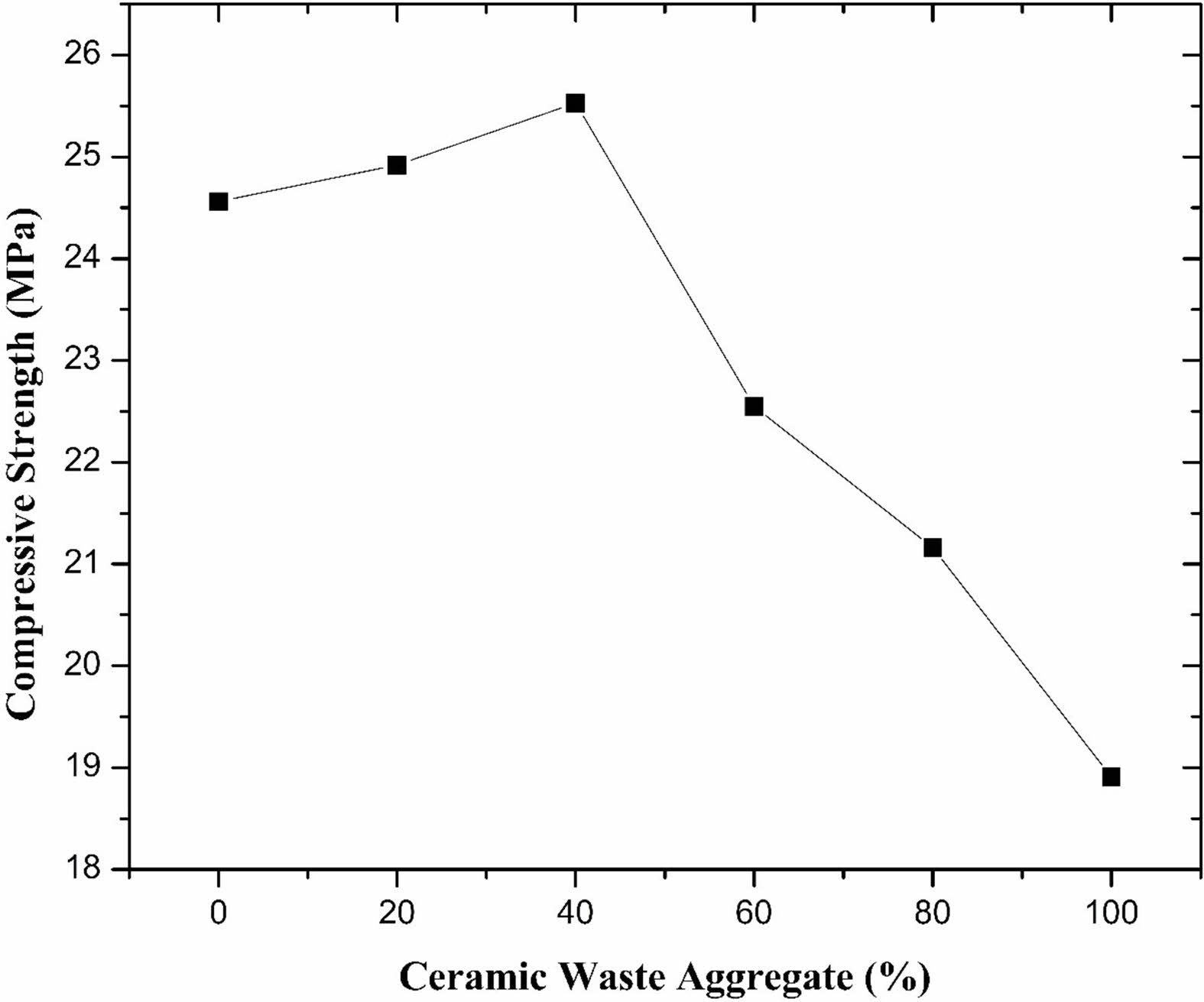
|
Fig. 8 The Effect of Ceramic Waste Aggregate on Concrete Compressive Strength (7 days). |
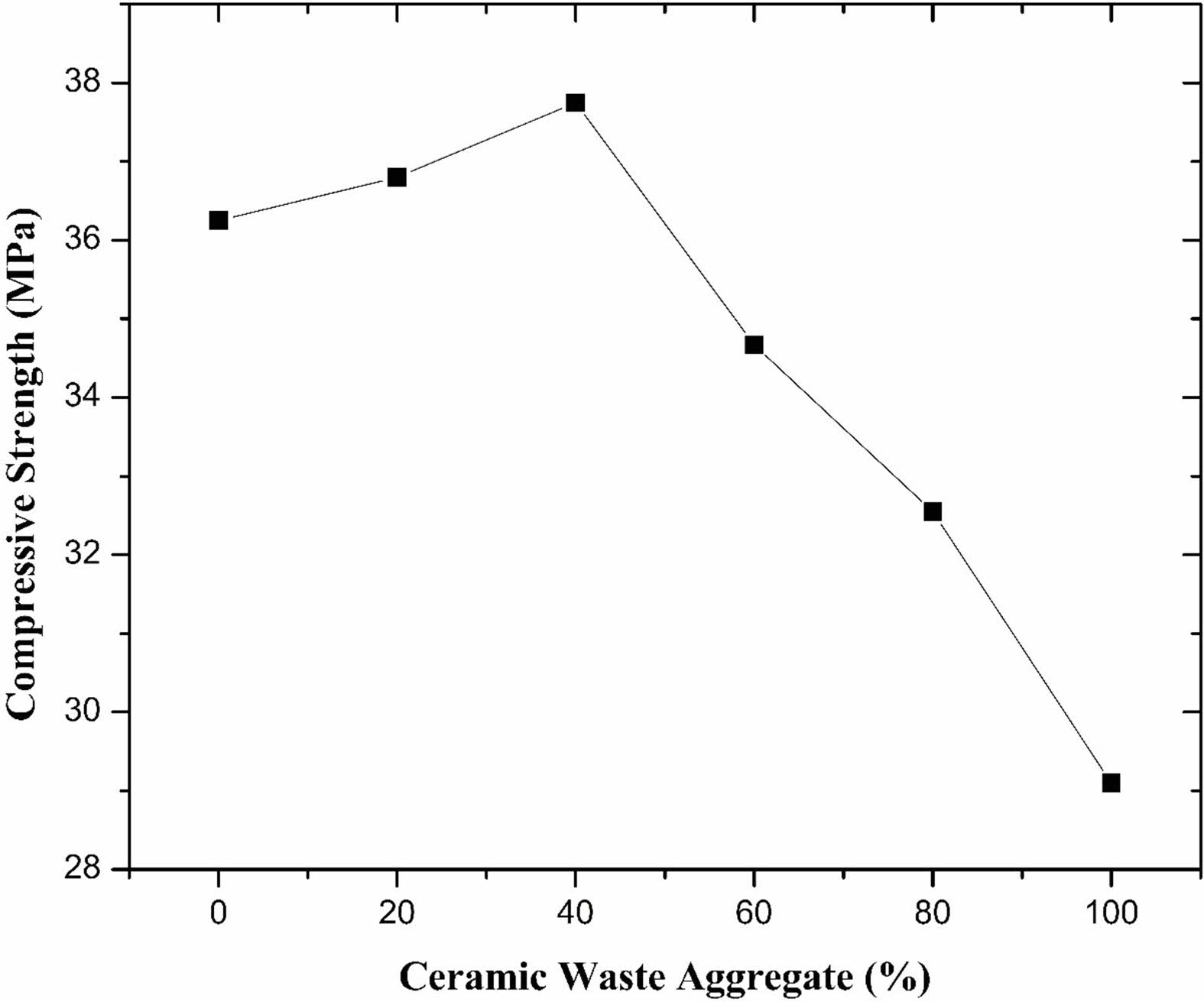
|
Fig. 9 Compressive Strength of Concrete Influenced by Ceramic Waste Aggregate (28 days). |
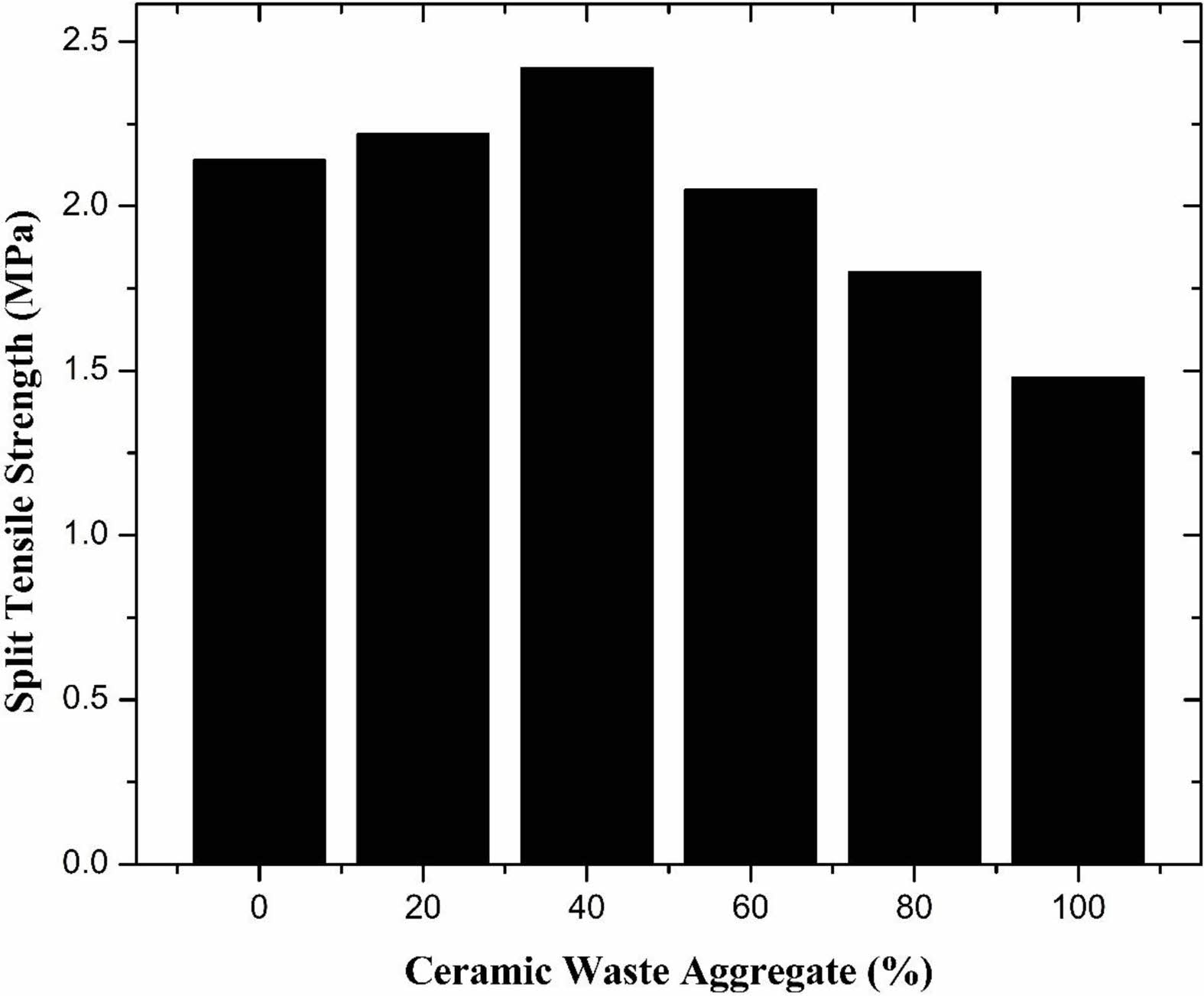
|
Fig. 10 Impact of Ceramic waste aggregate on Split tensile strength of concrete (7 days) |
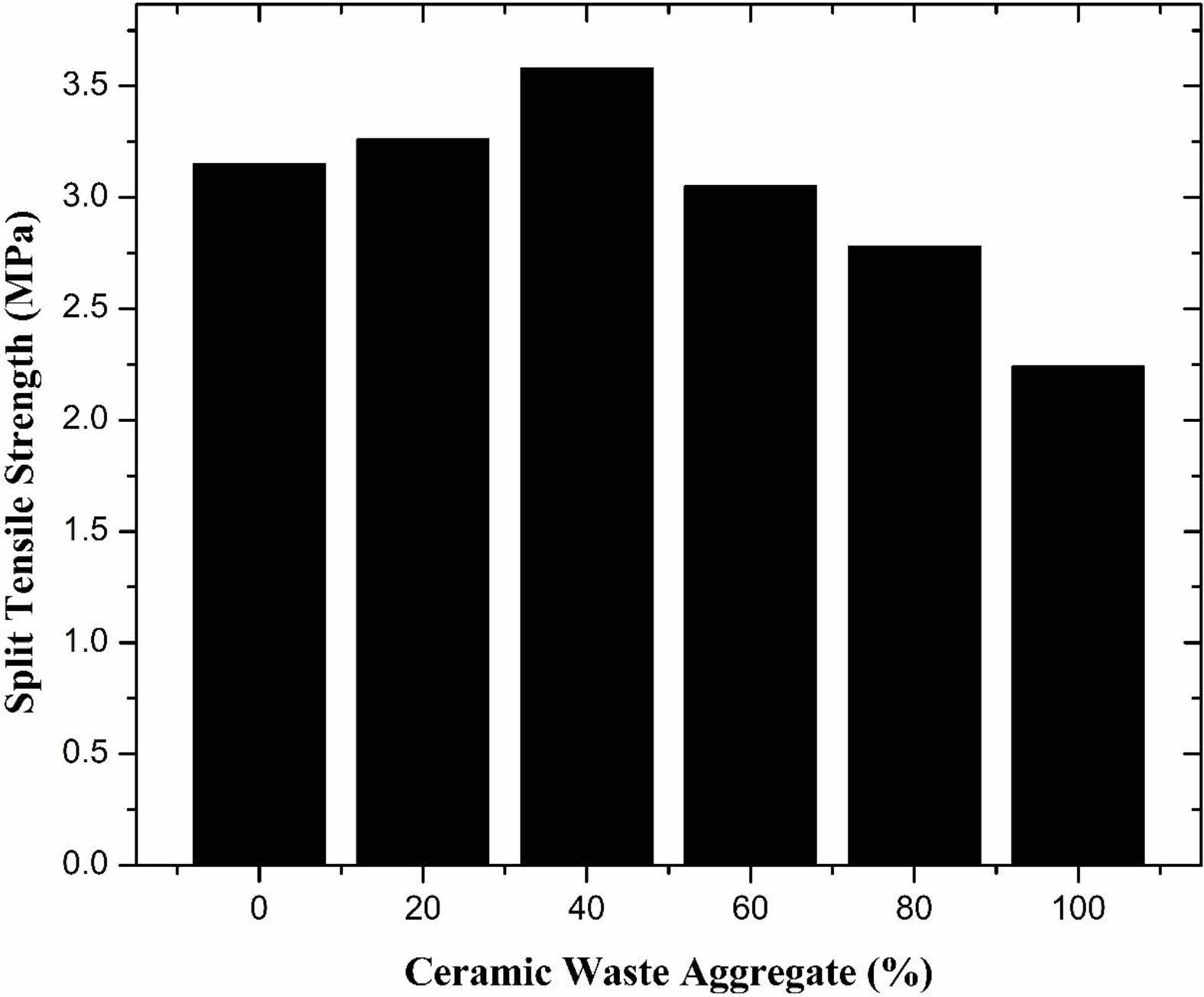
|
Fig. 11 Concrete split tensile strength is influenced by ceramic waste aggregate (28 days). |
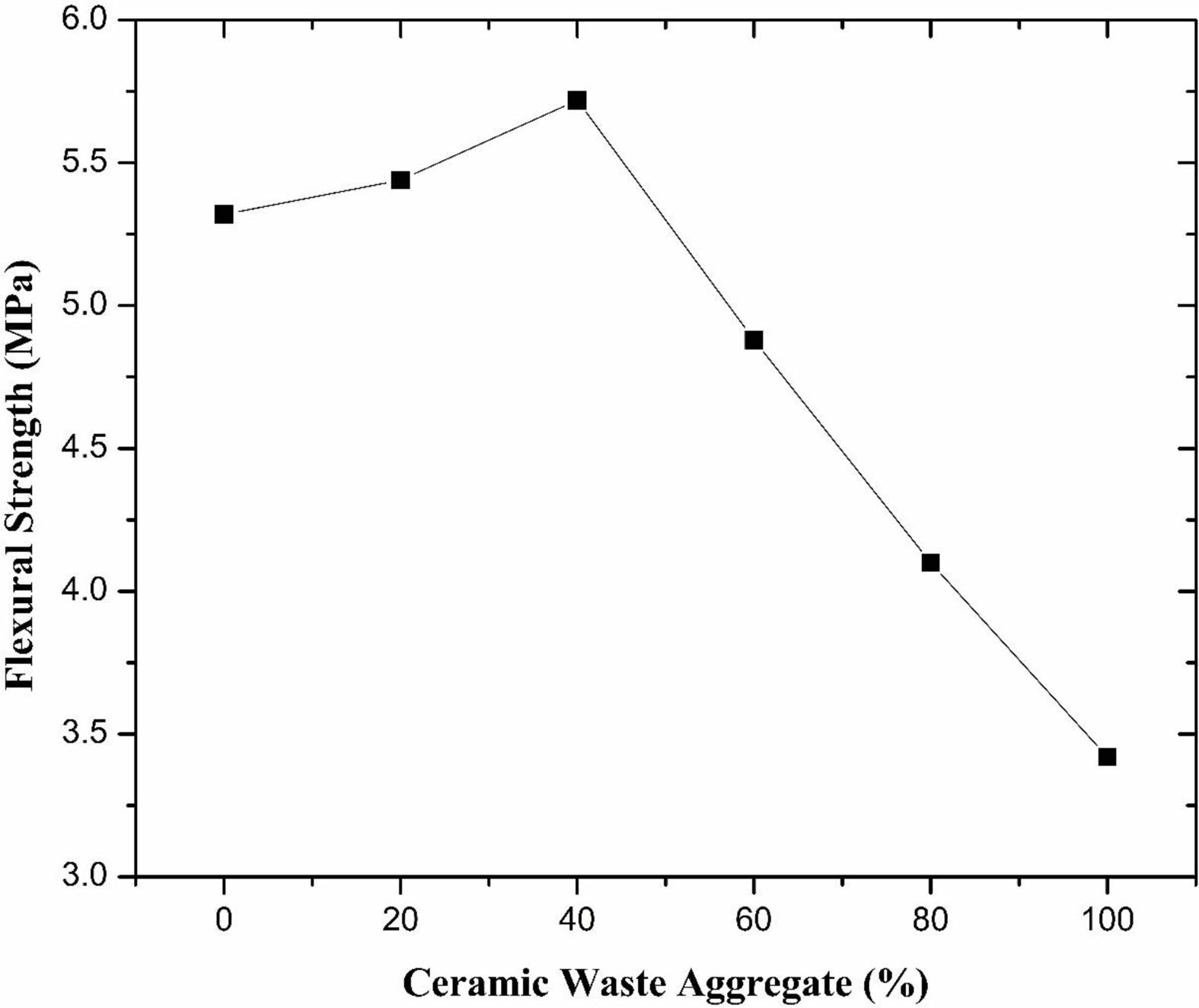
|
Fig. 12 The influence of ceramic waste aggregate on concrete flexural strength (28 days). |
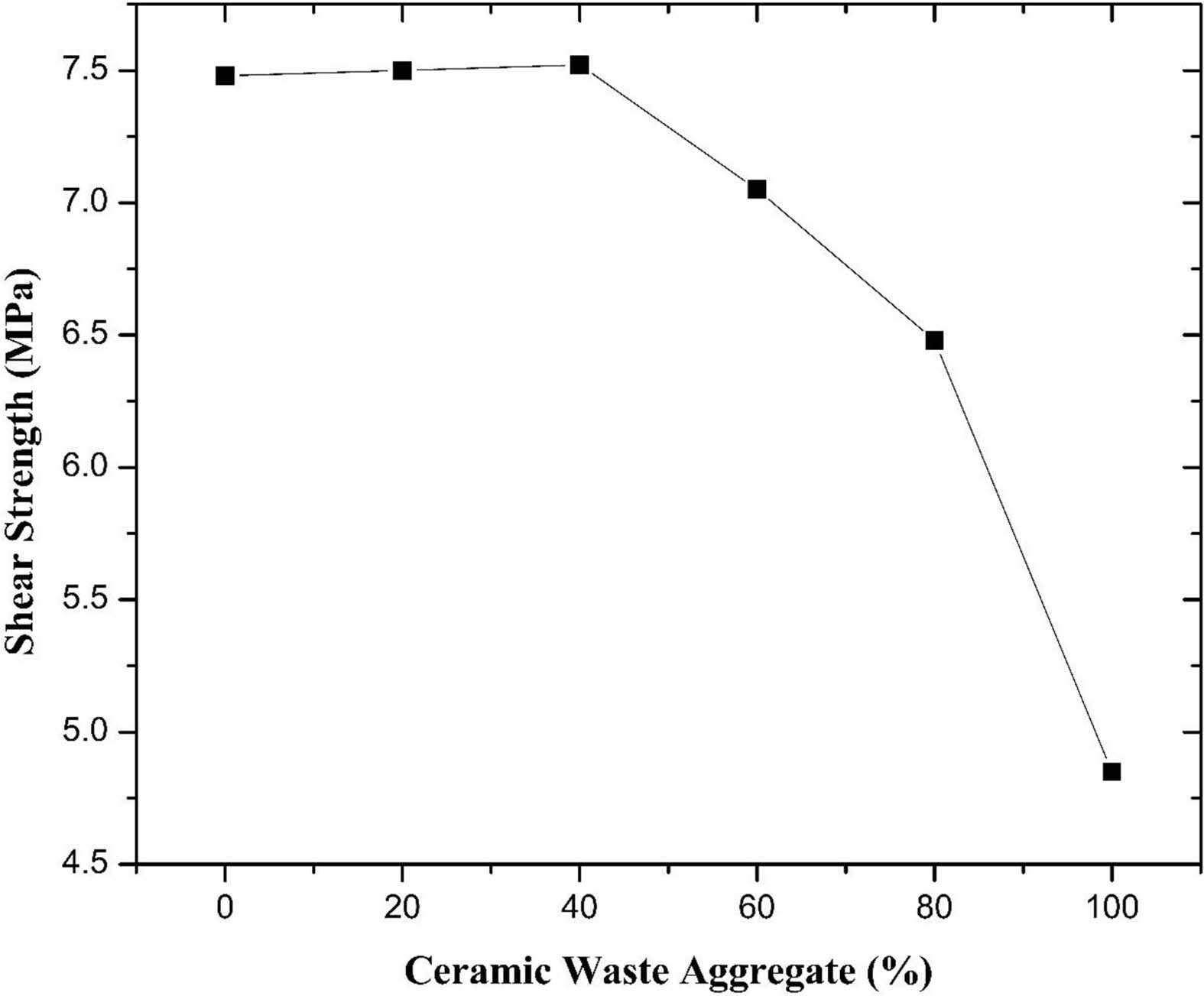
|
Fig. 13 The influence of ceramic waste aggregate on concrete shear strength (28 days). |
According to the findings of this study, Concrete can use ceramic waste material in place of natural coarse aggregate because mechanical characteristics of ceramic waste material are well within the range specified by IS: 383-1970. As a result, it is safe to use the ceramic waste aggregate in the concrete mixture.
Waste ceramic aggregate has several mechanical properties that are slightly superior to those of natural coarse aggregate, such as impact value, crushing value and abrasion value. However, waste ceramic aggregate can be safely used for coarse aggregate in concrete.
Comparison of compressive strengths of CC and CRWAC shows that when coarse aggregate is substituted for 40% by the ceramic waste aggregate, the strength is confirmed to be 4.13% greater.
The strength is confirmed to be 13.6% higher than that of conventional concrete specimens while comparing the split tensile strength in CC and CRWAC with 40% substitutions of ceramic waste aggregate with coarse aggregate.
When flexural strength in CC and CRWAC are compared, the 7.51% increase in strength over the conventional concrete specimen is confirmed by the replacement of coarse aggregate with ceramic waste aggregate at a rate of 40%.
The % replacement of coarse aggregate by ceramic waste aggregate while measuring the shear strengths of CC and CRWAC confirms the 0.53% strength increase over that of normal concrete specimens.
It is advised that ceramic waste aggregate can be utilized safely in concrete composition at a % replacement of natural aggregate when all strength considerations are taken into account.
The authors convey thanks to Sri Vinayaka Associates, Erode for materials fabrication.
- 1. N.M. Azmee and N. Shafiq, Case Stud. Constr. Mater. 9 (2018) e00197.
-

- 2. Bassam A. Tayeh, Doha M. Al Saffar, and Rayed Alyousef, J. Mater. Res. Technol. 9[4] (2020) 8469-8481.
-

- 3. A. Kumar and A. Agrawal, Curr. Res. Environ. Sustain. 2 (2020) 100011.
-

- 4. P. Ogrodnik and J. Szulej, 2nd International Conference on the Sustainable Energy and Environmental Development, (2019).
-

- 5. O.A. Ahmad, Int. J. Geomate 19[75] (2020) 8-18.
-

- 6. S. Ray, M. Haque, Md. M. Rahman, Md. N. Sakib, and K.A. Rakib, J. King Saud Uni.-Eng. Sci. (2021).
-

- 7. S. Ray, M. Haque, M.D.N. Sakib, A.F. Mita, M.D.M. Rahman, and B.B. Tanmoy, J. Build. Eng. 43 (2021) 102567.
-

- 8. R.K. Goyal, V. Agarwal, R. Gupta, K. Rathore, and P. Somani, Mater. Today: Proceed. 49[5] (2022) 1769-1775.
-

- 9. R.K. Dhirobe, J.D. Brito, R. Mangabhai, and Chao Qun Lye, Sustainable Constr. Mater. (2017) 27-86.
-

- 10. S. Chhetri, K. Neupane, N.P. Baral, and B. Bhandari, Int. J. Eng. Res. Technol. 10[3] (2021).
-

- 11. M. Samadi, G.F. Huseien, H. Mohammadhosseini, H.S. Lee, N.H.A.S. Lim, M. Md Tahir, and R. Alyousefd, J. Cleaner Product. 266[1] (2020) 121825.
-

- 12. H.M. Magbool, J. Build. Eng. 47[15] (2022) 103815.
-

- 13. R. Santhosh and P. Shivananda, J. Res. Appl. Sci. Eng. Technol. 5[11] (2017).
- 14. Z. Ralli and S.J. Pantazopoulou, National Accelerated Bridge Construction Conference including Automation (2019).
- 15. O. Cazacu and B. Revil-Baudard, Plast. Metal. Mater. (2021) 311-424.
-

- 16. G. Jumaa and A.R. Yousif, J. Civil Eng. (2019).
-

- 17. S.A. Kristiawan, H.A. Saifullah, and A. Supriyadi, Infrastructures 6[97] (2021).
-

- 18. X. Fan, H. Lin, H. Lai, R. Cao, and J. Liu, Comptes. Rendus. Mecanique. 347[1] (2019) 33-48.
-

- 19. Y. Xu, Y.L. Wong, C.S. Poon, and M. Anson, Cem. Concr. Res. 33[12] (2003) 2009-2016.
-

- 20. M. Daniyal and S. Ahmad, Int. J. Innovative Research in Science, Engineering and Technology 4[12] (2015).
-

- 21. H.G. Shruthi, M.E. Gowtham Prasad, Samreen Taj, and Syed Ruman Pasha, Int. Res. J. Eng. Technol. 3[7] (2016).
- 22. B. Subedi, D.K. Wagle, and K. Basnet, Int. J. Eng. Res. Technol. 9[7] (2020).
-

- 23. M.O. Younis, M. Amin, and M.A. Tahwia, Case Studies Constr. Mater. 17 (2022).
-

- 24. K. Ramadevi, Int. J. Civil Eng. Technol. 8[8] (2017).
- 25. M.S.M. Taj, A. Manivannan, A. Agalya, and M. Sriranjani, Int. J. Innovative Sci. Res. Technol. 3[5] (2018).
- 26. G. Sai Chand and P. Ravi Kumar, Int. J. Eng. Res. A Peer Rev. Int. J. 5[3] (2017).
- 27. J. Bommisetty, T.S. Keertan, A. Ravitheja, and K. Mahendra, Mater. Today: Proceed. 8 (2019) 230.
-

- 28. H.W. Hasan, S. Alamgir, H. Ahmed, and S. Mubin, Pakistan J. Sci. 66[1] (2014).
- 29. J. Bommisetty, T.S. Keertana, A. Ravitheja, and K. Mahendra, Mater. Today: Proceed. 19[2] (2019) 875-877.
-

- 30. E.E. Ikponmwosa and S.O. Ehikhuenmen, Nigerian J. Technol. 36[3] (2017).
- 31. H.M. Najm and S. Ahmadm, Res. Square (2022).
 This Article
This Article
-
2023; 24(2): 266-273
Published on Apr 30, 2023
- 10.36410/jcpr.2023.24.2.266
- Received on Aug 12, 2022
- Revised on Oct 10, 2022
- Accepted on Nov 19, 2022
 Services
Services
- Abstract
introduction
materials and methods
results and discussion
conclusion
- Acknowledgements
- References
- Full Text PDF
Shared
 Correspondence to
Correspondence to
- M. Harikaran
-
Assistant Professor, Department of Civil Engineering, Muthayammal Engineering College, Rasipuram - 637408, Tamilnadu, India
Tel : +9524957886 - E-mail: drmharikaran@gmail.com






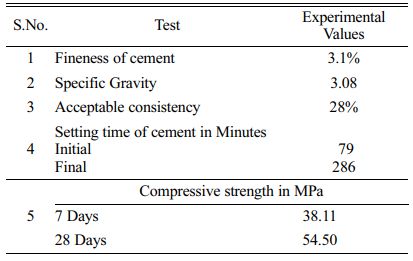
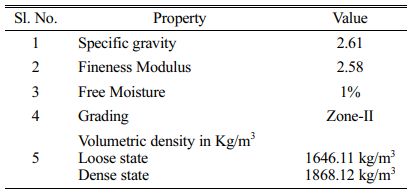
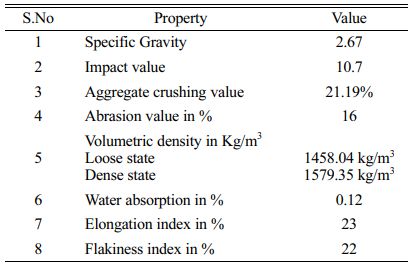
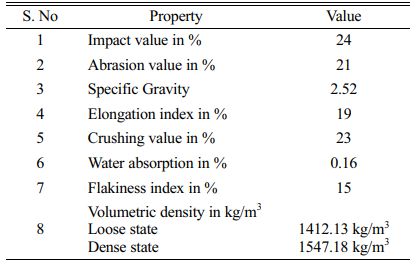

 Copyright 2019 International Orgranization for Ceramic Processing. All rights reserved.
Copyright 2019 International Orgranization for Ceramic Processing. All rights reserved.